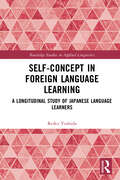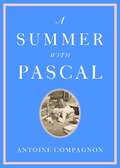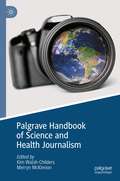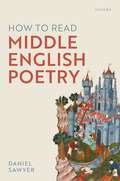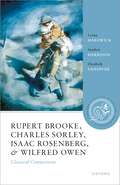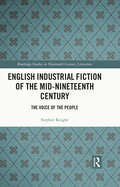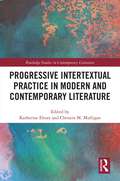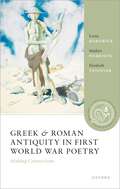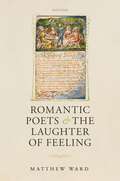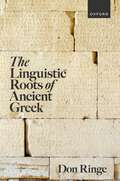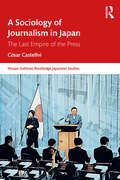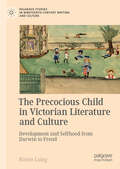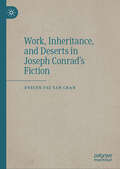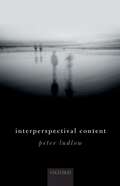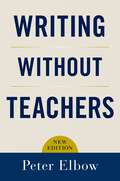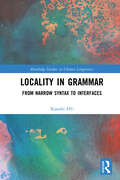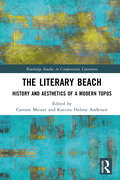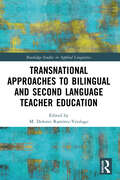- Table View
- List View
Self-Concept in Foreign Language Learning: A Longitudinal Study of Japanese Language Learners (Routledge Studies in Applied Linguistics)
by Reiko YoshidaThis book explores self-concept in foreign language (FL) learning, tracing the trajectories of a group of Japanese language learners at an Australian university to illuminate new insights about the factors impacting positive self-concept and implications for language learning more broadly.The volume calls attention to the ways in which learners’ perception of themselves as FL learners plays a fundamental role in FL learning. Drawing on data from a longitudinal study, including student diaries, interviews and classroom observations, Yoshida outlines shifts in self-concept as learners progress from secondary school to university courses to study abroad and beyond. The book demonstrates how the learner journey is marked by a growing recognition of the importance of practice for achievement but also a greater sense of self-consciousness, with learners’ agency in creating opportunities for themselves to practice their FL as a key factor in improving self-concept over time. This work offers unique observations about self-concept for learners who already ‘have’ global English as a first language, inspiring ways forward for future research and language teaching in other under-studied languages. The book will appeal to students and researchers in applied linguistics, SLA and foreign language learning, as well as stakeholders in Japanese language programs.
Self-Concept in Foreign Language Learning: A Longitudinal Study of Japanese Language Learners (Routledge Studies in Applied Linguistics)
by Reiko YoshidaThis book explores self-concept in foreign language (FL) learning, tracing the trajectories of a group of Japanese language learners at an Australian university to illuminate new insights about the factors impacting positive self-concept and implications for language learning more broadly.The volume calls attention to the ways in which learners’ perception of themselves as FL learners plays a fundamental role in FL learning. Drawing on data from a longitudinal study, including student diaries, interviews and classroom observations, Yoshida outlines shifts in self-concept as learners progress from secondary school to university courses to study abroad and beyond. The book demonstrates how the learner journey is marked by a growing recognition of the importance of practice for achievement but also a greater sense of self-consciousness, with learners’ agency in creating opportunities for themselves to practice their FL as a key factor in improving self-concept over time. This work offers unique observations about self-concept for learners who already ‘have’ global English as a first language, inspiring ways forward for future research and language teaching in other under-studied languages. The book will appeal to students and researchers in applied linguistics, SLA and foreign language learning, as well as stakeholders in Japanese language programs.
A Summer with Pascal
by Antoine CompagnonFrom an eminent scholar, a spirited introduction to one of the great polymaths in the history of Europe.Blaise Pascal (1623–1662) is best known in the English-speaking world for his contributions to mathematics and physics, with both a triangle and a law in fluid mechanics named after him. Meanwhile, the classic film My Night at Maud’s popularized Pascal’s wager, an invitation to faith that has inspired generations of theologians. Despite the immensity of his reputation, few read him outside French schools. In A Summer with Pascal, celebrated literary critic Antoine Compagnon opens our minds to a figure somehow both towering and ignored.Compagnon provides a bird’s-eye view of Pascal’s life and significance, making this volume an ideal introduction. Still, scholars and neophytes alike will profit greatly from his masterful readings of the Pensées—a cornerstone of Western philosophy—and the Provincial Letters, in which Pascal advanced wry theological critiques of his contemporaries. The concise, taut chapters build upon one another, easing into writings often thought to be forbidding and dour. With Compagnon as our guide, these works are not just accessible but enchanting.A Summer with Pascal brings the early modern thinker to life in the present. In an age of profound existential doubt and assaults on truth and reason, in which religion and science are so often crudely opposed, Pascal’s sophisticated commitment to both challenges us to meet the world with true intellectual vigor.
Palgrave Handbook of Science and Health Journalism
by Kim Walsh-Childers Merryn McKinnonThis handbook reviews the extant literature on the most important issues in health and science journalism, with a focus on summarizing the relevant research and identifying key questions that are yet to be answered. It explores challenges and best practices in health and science reporting, formats and audiences, key topics such as climate change, pandemics and space science, and the ethics and political impacts of science and health journalist practice. With numerous international contributions, it provides a comprehensive overview of an emerging area of journalism studies and science communication.
How to Read Middle English Poetry
by Daniel SawyerHow to Read Middle English Poetry guides readers through poetry between 1150 and 1500, for study and pleasure. Chapters give down-to-earth advice on enjoying and analyzing each aspect of verse, from the choice of single words, through syntax, metre, rhyme, and stanza-design, up to the play of larger forms across whole poems. How to Read Middle English Poetry covers major figures?such as Chaucer, Langland, the Pearl Poet, and Robert Henryson?but also delves into exciting anonymous lyrics, romances, and drama. It shows, too, how some modern poets have drawn on earlier poems, and how Middle English and early Scots provide crucial standpoints from which to think through present-day writing. Contextual sections discuss how poetry was heard aloud, introduce manuscripts and editing, and lay out Middle English poetry's ties to other tongues, including French, Welsh, and Latin. Critical terms are highlighted and explained both in the main text and in a full indexed glossary, while the uses of key tools such as the Middle English Dictionary are described and modeled. References to accessible editions and electronic resources mean that the book needs no accompanying anthology. At once thorough, wide-ranging, and practical, How to Read Middle English Poetry is indispensable for students exploring Middle English or early Scots, and for anyone curious about the heart of poetry's history.
Rupert Brooke, Charles Sorley, Isaac Rosenberg, and Wilfred Owen: Classical Connections (Oxford Classical Reception Commentaries)
by Lorna Hardwick Stephen Harrison Elizabeth VandiverRupert Brooke, Wilfred Owen, Isaac Rosenberg, and Charles Sorley all died in the First Word War. They came from diverse social, educational, and cultural backgrounds, but for all of the writers, engagement with Greek and Roman antiquity was decisive in shaping their war poetry. The world views and cultural hinterlands of Brooke and Sorley were framed by the Greek and Latin texts they had studied at school, whereas for Owen, who struggled with Latin, classical texts were a part of his aspirational literary imagination. Rosenberg's education was limited but he encountered some Greek and Roman literature through translations, and through mediations in English literature. The various ways in which the poets engaged with classical literature are analysed in the commentaries, which are designed to be accessible to classicists and to users from other subject areas. The extensive range of connections made by the poets and by subsequent readers is explained in the Introduction to the volume. The commentaries illuminate relationships between the poems and attitudes to the war at the time, in the immediate post-war years, and subsequently. They also probe how individual poems reveal various facets of the poetry of unease, the poetry of survival, and the poetics of war and ecology. References to the accompanying online Oxford Classical Receptions Commentaries will enable readers to follow up their special interests. This volume differs from the shorter volume Greek and Roman Antiquity in First World War Poetry: Making Connections in that it covers the whole output of the four poets, and not just their war poems.
English Industrial Fiction of the Mid-Nineteenth Century: The Voice of the People (Routledge Studies in Nineteenth Century Literature)
by Stephen KnightEnglish Industrial Fiction of the Mid-Nineteenth Century discusses the valuable fiction written in mid-nineteenth-century Britain which represents the situations of the new breed of industrial workers, both the mostly male factory workers who operated in the oppressive mills of the midlands and north and, in other stories, the oppressed seamstresses who worked mostly in London in very poor and low-paid conditions. Beginning with a general introduction to workers’ fiction at the start of the period, this volume charts the rise of an identifiable genre of industrial fiction and the development of a substantial mode of seamstress fiction through the 1840s, including an analysis of novels by Benjamin Disraeli, Charles Kingsley, Elizabeth Gaskell and Charles Dickens, and more briefly Charlotte Bronte, Geraldine Jewsbury and George Eliot. This volume is essential reading for students and scholars of industrial fiction and nineteenth-century Britain, or those with an interest in the relationship between literature, society and politics.
English Industrial Fiction of the Mid-Nineteenth Century: The Voice of the People (Routledge Studies in Nineteenth Century Literature)
by Stephen KnightEnglish Industrial Fiction of the Mid-Nineteenth Century discusses the valuable fiction written in mid-nineteenth-century Britain which represents the situations of the new breed of industrial workers, both the mostly male factory workers who operated in the oppressive mills of the midlands and north and, in other stories, the oppressed seamstresses who worked mostly in London in very poor and low-paid conditions. Beginning with a general introduction to workers’ fiction at the start of the period, this volume charts the rise of an identifiable genre of industrial fiction and the development of a substantial mode of seamstress fiction through the 1840s, including an analysis of novels by Benjamin Disraeli, Charles Kingsley, Elizabeth Gaskell and Charles Dickens, and more briefly Charlotte Bronte, Geraldine Jewsbury and George Eliot. This volume is essential reading for students and scholars of industrial fiction and nineteenth-century Britain, or those with an interest in the relationship between literature, society and politics.
Progressive Intertextual Practice In Modern And Contemporary Literature (Routledge Studies in Contemporary Literature)
This edited volume aims to reposition intertextuality in relation to recent trends in critical practice. Inspired by the work of Sara Ahmed in particular, our authors explore and reconfigure classic theories of authorship, influence and the text (including those by Roland Barthes, Michel Foucault and Harold Bloom), updating these conversations to include intersectionality specifically, broadly understood to include gendered, racial and other forms of social justice including disability, and the progressive impact of the transmission and transformation of texts. This diverse volume includes discussions of major canonical works such as James Joyce’s Ulysses alongside the recent contemporary literature by authors such as Siri Husvedt and Maggie O’Farrell, as well as theoretical interventions. This volume also engages with how intertextuality can facilitate interdisciplinary and ekphrastic thinking and representation, as the inspiration of music and the visual arts for texts and their transmission is addressed. The choice of intertexts become deliberately political, ethical and artistic signifiers for the authors discussed in this volume, and our contributors are thus enabled to address topics ranging from visual impairment to Shakespearean motherhood to the influence of Jazz culture on writing on the Northern Irish Troubles.
Greek and Roman Antiquity in First World War Poetry: Making Connections (Oxford Classical Reception Commentaries)
by Lorna Hardwick Stephen Harrison Elizabeth VandiverRupert Brooke, Wilfred Owen, Isaac Rosenberg, and Charles Sorley all died in the First Word War. They came from diverse social, educational, and cultural backgrounds, but for all of the writers, engagement with Greek and Roman antiquity was decisive in shaping their war poetry. The world views and cultural hinterlands of Brooke and Sorley were framed by the Greek and Latin texts they had studied at school, whereas for Owen, who struggled with Latin, classical texts were a part of his aspirational literary imagination. Rosenberg's education was limited but he encountered some Greek and Roman literature through translations, and through mediations in English literature. The various ways in which the poets engaged with classical literature are analysed in the commentaries, which are designed to be accessible to classicists and to users from other subject areas. The extensive range of connections made by the poets and by subsequent readers is explained in the Introduction to the volume. The commentaries illuminate relationships between the poems and attitudes to the war at the time, in the immediate post-war years, and subsequently. They also probe how individual poems reveal various facets of the poetry of unease, the poetry of survival, and the poetics of war and ecology.
How to Read Middle English Poetry
by Daniel SawyerHow to Read Middle English Poetry guides readers through poetry between 1150 and 1500, for study and pleasure. Chapters give down-to-earth advice on enjoying and analyzing each aspect of verse, from the choice of single words, through syntax, metre, rhyme, and stanza-design, up to the play of larger forms across whole poems. How to Read Middle English Poetry covers major figures?such as Chaucer, Langland, the Pearl Poet, and Robert Henryson?but also delves into exciting anonymous lyrics, romances, and drama. It shows, too, how some modern poets have drawn on earlier poems, and how Middle English and early Scots provide crucial standpoints from which to think through present-day writing. Contextual sections discuss how poetry was heard aloud, introduce manuscripts and editing, and lay out Middle English poetry's ties to other tongues, including French, Welsh, and Latin. Critical terms are highlighted and explained both in the main text and in a full indexed glossary, while the uses of key tools such as the Middle English Dictionary are described and modeled. References to accessible editions and electronic resources mean that the book needs no accompanying anthology. At once thorough, wide-ranging, and practical, How to Read Middle English Poetry is indispensable for students exploring Middle English or early Scots, and for anyone curious about the heart of poetry's history.
Progressive Intertextual Practice In Modern And Contemporary Literature (Routledge Studies in Contemporary Literature)
by Katherine Ebury Christin M. MulliganThis edited volume aims to reposition intertextuality in relation to recent trends in critical practice. Inspired by the work of Sara Ahmed in particular, our authors explore and reconfigure classic theories of authorship, influence and the text (including those by Roland Barthes, Michel Foucault and Harold Bloom), updating these conversations to include intersectionality specifically, broadly understood to include gendered, racial and other forms of social justice including disability, and the progressive impact of the transmission and transformation of texts. This diverse volume includes discussions of major canonical works such as James Joyce’s Ulysses alongside the recent contemporary literature by authors such as Siri Husvedt and Maggie O’Farrell, as well as theoretical interventions. This volume also engages with how intertextuality can facilitate interdisciplinary and ekphrastic thinking and representation, as the inspiration of music and the visual arts for texts and their transmission is addressed. The choice of intertexts become deliberately political, ethical and artistic signifiers for the authors discussed in this volume, and our contributors are thus enabled to address topics ranging from visual impairment to Shakespearean motherhood to the influence of Jazz culture on writing on the Northern Irish Troubles.
Romantic Poets and the Laughter of Feeling
by Matthew WardThe Romantic period witnessed decisive interest in how feeling might align with forms of artistic expression. Many critical studies have focused on the serious side and melancholic moods of Romantic poets. Romantic Poets and the Laughter of Feeling instead embraces the sublime and the ridiculous to offer an original and compelling new reading of British Romanticism. It reveals the decisive role laughter and the laughable play in Romantic aesthetics, emotions, and ethics. Matthew Ward shows that laughter was one of the primary means by which Romantics embraced and expanded upon, but also frequently aped and lampooned, sympathetic feeling. The laughter of feeling is both the expression of sympathy and an articulation of its implications, prejudices, and constraints. For Romantic poets like Wordsworth, Shelley, and Keats, the sound of laughter carries the hope that greater knowledge of others derives from feeling for and with them through poetry, and this might lead to a better understanding of oneself. Yet laughter also makes these poets acutely aware that our emotional lives are utterly unfamiliar and perhaps ultimately unknowable. Their prosody of laughter enlivens and exposes; it embodies their sense of?and ambitions for?poetry, and yet calls those matters into the most comical and gravest doubt. Laughter helps define what it is to be human. This book shows that it also defines what it is to be a 'Romantic' poet.
The Linguistic Roots of Ancient Greek
by Don RingeThis book traces the development of Greek from Proto-Indo-European to around the 5th century BC, drawing on all the tools of scientific historical and comparative linguistics. Don Ringe begins by outlining the grammar of Proto-Indo-European, focusing on its complex phonology, phonological rules, and inflectional morphology. He then discusses the changes in both phonology and inflectional morphology that took place in the development of Greek up to the point at which the dialects began to diverge, seeking to establish chronological relationships between those changes. The book places particular emphasis on the diversification of Greek into the attested groups of dialects, the relationship between those dialects, and the extent to which innovations spread across dialect boundaries. The final two chapters cover syntactic changes in the prehistory and history of Ancient Greek, and the sources of the Ancient Greek lexicon. The volume contributes to long-standing debates surrounding the classification of Ancient Greek dialects, and offers a discussion of the tension between cladistics and contact phenomena that is relevant to the study of the relationships within any language family.
A Sociology of Journalism in Japan: The Last Empire of the Press (ISSN)
by César CastellviThis book represents an in-depth analysis of journalism in Japan during the golden era of the daily press and the gradual introduction of digital technology starting from the mid-1980s to the late 2010s.By presenting firsthand testimony from journalists and field notes collected from fieldwork in the newsroom of one of the country's largest newspapers, this book provides a unique insight into Japan’s highly active yet relatively under-institutionalized journalistic profession. It also explores the changes experienced by the organizational development of Japanese journalism in response to broader changes in Japanese society, such as the emergence of social networks, the evolution of reading practices, the demographic situation, and the new aspirations of the Japanese youth.Based on an extensive ethnographic fieldwork carried out by the author over several years, this book will be of huge interest to students and scholars of Japanese society, journalism, and media studies.
A Sociology of Journalism in Japan: The Last Empire of the Press (ISSN)
by César CastellviThis book represents an in-depth analysis of journalism in Japan during the golden era of the daily press and the gradual introduction of digital technology starting from the mid-1980s to the late 2010s.By presenting firsthand testimony from journalists and field notes collected from fieldwork in the newsroom of one of the country's largest newspapers, this book provides a unique insight into Japan’s highly active yet relatively under-institutionalized journalistic profession. It also explores the changes experienced by the organizational development of Japanese journalism in response to broader changes in Japanese society, such as the emergence of social networks, the evolution of reading practices, the demographic situation, and the new aspirations of the Japanese youth.Based on an extensive ethnographic fieldwork carried out by the author over several years, this book will be of huge interest to students and scholars of Japanese society, journalism, and media studies.
The Precocious Child in Victorian Literature and Culture: Development and Selfhood from Darwin to Freud (Palgrave Studies in Nineteenth-Century Writing and Culture)
by Roisín LaingThis book examines representations of precocity in Victorian textual culture – canonical literature, children’s fiction, scientific texts, and writing by children – to argue that precocity challenges the idea of progress. It considers how practitioners of literature and science from Wordsworth to Freud represented human development, and the way in which Darwin’s “non-progressive model of evolution” troubled the existing model of progression by stages (from childhood inexperience to adult maturity and understanding). Roisín Laing argues that the precocious child undermines the equation of growth with progress, and thereby facilitates other ways of imagining both individual and species development. The idea represented by the precocious child in Victorian culture – that the adult is not necessarily an improvement on the child, the human not necessarily an improvement on the ape – still troubles us today.
Work, Inheritance, and Deserts in Joseph Conrad’s Fiction
by Evelyn Tsz ChanThis book focuses on the complex relationships between inheritance, work, and desert in literature. It shows how, from its manifestation in the trope of material inheritance and legacy in Victorian fiction, “inheritance” gradually took on additional, more modern meanings in Joseph Conrad’s fiction on work and self-making. In effect, the emphasis on inheritance as referring to social rank and wealth acquired through birth shifted to a focus on talent, ability, and merit, often expressed through work.The book explores how Conrad’s fiction engaged with these changing modes of inheritance and work, and the resulting claims of desert they led to. Uniquely, it argues that Conrad’s fiction critiques claims of desert arising from both work and inheritance, while also vividly portraying the emotional costs and existential angst that these beliefs in desert entailed. The argument speaks to and illuminates today’s debates on moral desert arising from work and inheritance, in particular from meritocratic ideals. Its new approach to Conrad’s works will appeal to students and scholars of Conrad and literary modernism, as well as a wider audience interested in philosophical and social debates on desert deriving from inheritance and work.
Interperspectival Content
by Peter LudlowToo often today it seems we find ourselves communicating from radically different perspectives on the world and we often despair of communication even being possible. Peter Ludlow argues that perspectival content, or what some call indexical content, is ineliminable and ubiquitous, running through our accounts of human action and emotions, perception, normative behaviour, and even our theories of computation and information. While such content may be ineliminable, it also gives rise to philosophical puzzles - particularly those involving reporting these contents from different perspectival positions. Such puzzles have led some to try and abandon perspectival content, and others to despair of communication across diverse perspectival positions. Ludlow argues that communication across diverse perspectival positions is not only possible, but routine, and develops a theory of interperspectival content and cognitive dynamics to explain how it is accomplished.
Writing without Teachers
by Peter ElbowIn Writing Without Teachers, well-known advocate of innovative teaching methods Peter Elbow outlines a practical program for learning how to write. His approach is especially helpful to people who get "stuck" or blocked in their writing, and is equally useful for writing fiction, poetry, and essays, as well as reports, lectures, and memos. The core of Elbow's thinking is a challenge against traditional writing methods. Instead of editing and outlining material in the initial steps of the writing process, Elbow celebrates non-stop or free uncensored writing, without editorial checkpoints first, followed much later by the editorial process. This approach turns the focus towards encouraging ways of developing confidence and inspiration through free writing, multiple drafts, diaries, and notes. Elbow guides the reader through his metaphor of writing as "cooking:" his term for heating up the creative process where the subconscious bubbles up to the surface and the writing gets good. 1998 marks the twenty-fifth anniversary of Writing Without Teachers. In this edition, Elbow reexamines his program and the subsequent influence his techniques have had on writers, students, and teachers. This invaluable guide will benefit anyone, whether in the classroom, boardroom, or living room, who has ever had trouble writing.
Locality in Grammar: From Narrow Syntax to Interfaces (Routledge Studies in Chinese Linguistics)
by Xiaoshi HuLocality in Grammar: From Narrow Syntax to Interfaces investigates the operation of locality conditions in syntax and semantics from a cross-linguistic perspective.It is claimed that there are two different types of locality conditions. One is the Generalized Minimality Condition (GMC), and the other is the Phase Impenetrability Condition (PIC). This book demonstrates that these locality conditions play different roles in different computational components of human language, and, therefore, cannot be unified as one constraint as proposed in the literature.The main idea of the book is that the two different locality conditions are sensitive to the difference between syntactic derivation and semantic interpretation and that of overt and covert syntactic derivations. Further investigation shows a more fine-grained distinction must be made between syntactic computations. It is true that GMC does not constrain overt syntactic derivations and PIC does not play a role in semantic interpretations; however, they both regulate covert syntactic computations.This book will inform postgraduate students and scholars in the field of linguistics.
Locality in Grammar: From Narrow Syntax to Interfaces (Routledge Studies in Chinese Linguistics)
by Xiaoshi HuLocality in Grammar: From Narrow Syntax to Interfaces investigates the operation of locality conditions in syntax and semantics from a cross-linguistic perspective.It is claimed that there are two different types of locality conditions. One is the Generalized Minimality Condition (GMC), and the other is the Phase Impenetrability Condition (PIC). This book demonstrates that these locality conditions play different roles in different computational components of human language, and, therefore, cannot be unified as one constraint as proposed in the literature.The main idea of the book is that the two different locality conditions are sensitive to the difference between syntactic derivation and semantic interpretation and that of overt and covert syntactic derivations. Further investigation shows a more fine-grained distinction must be made between syntactic computations. It is true that GMC does not constrain overt syntactic derivations and PIC does not play a role in semantic interpretations; however, they both regulate covert syntactic computations.This book will inform postgraduate students and scholars in the field of linguistics.
The Literary Beach: History and Aesthetics of a Modern Topos (Routledge Studies in Comparative Literature)
As a geo-historical place, the beach integrates a variety of characteristics and functions so multiple that they tend to contradict each other. The beach is both a place of work and trade but also of leisure; it is both a place of therapy and health but also of migration, war, and death; it is a place of mass tourism and boredom but also the place of experiencing the Other; it is a public place but also an uncivilized and desolate place.This book studies the literary representation of the beach from ancient Greek literature up until today, drawing on English, French, Italian, American, and Spanish literatures from various periods and genres and presenting multiple ways of comparing and understanding literary beaches as a ubiquitous literary phenomenon. It demonstrates how the literary beach as a both geo-historical place and as an aesthetic literary commonplace has been a constant and privileged resource for the analysis of more general existential, sociological, and moral problems. This is the case when for instance the Tahitian beach becomes the place of the "already modern" in Stevenson's tales, or when the Italian beach becomes a question of modern feminism in Ferrante.In this sense, literature expands the local or national beach by articulating its transnational complexities.
The Literary Beach: History and Aesthetics of a Modern Topos (Routledge Studies in Comparative Literature)
by Carsten Meiner Katrine Helene AndersenAs a geo-historical place, the beach integrates a variety of characteristics and functions so multiple that they tend to contradict each other. The beach is both a place of work and trade but also of leisure; it is both a place of therapy and health but also of migration, war, and death; it is a place of mass tourism and boredom but also the place of experiencing the Other; it is a public place but also an uncivilized and desolate place.This book studies the literary representation of the beach from ancient Greek literature up until today, drawing on English, French, Italian, American, and Spanish literatures from various periods and genres and presenting multiple ways of comparing and understanding literary beaches as a ubiquitous literary phenomenon. It demonstrates how the literary beach as a both geo-historical place and as an aesthetic literary commonplace has been a constant and privileged resource for the analysis of more general existential, sociological, and moral problems. This is the case when for instance the Tahitian beach becomes the place of the "already modern" in Stevenson's tales, or when the Italian beach becomes a question of modern feminism in Ferrante.In this sense, literature expands the local or national beach by articulating its transnational complexities.
Transnational Approaches to Bilingual and Second Language Teacher Education (Routledge Studies in Applied Linguistics)
by M. Dolores Ramírez-VerdugoThis innovative collection explores transnational approaches to bilingual teacher education from different angles, unpacking the challenges and opportunities in contemporary global bilingual programs.The book offers a thorough account of transnational pedagogical research and best practice in bilingual and second language education to advance bilingual and content and language integrated learning (CLIL) teacher education programs across international contexts, including Australia, Mexico, the United States, the United Kingdom, and around Europe. The book offers a window into better understanding issues around research outcomes on bilingual education professional development models adaptable for diverse settings, translanguaging pedagogy, creative and multimodal tools, and methodological strategies. The book also examines the challenges involved in plurilingual classrooms and formal and informal bilingual education in urban and rural areas. Influenced by the demands raised by the pandemic, some chapters discuss integrated frameworks for hybrid language learning in distance education. This volume will be of interest to students and scholars in bilingual teacher education, bilingual and second language education, and CLIL.
